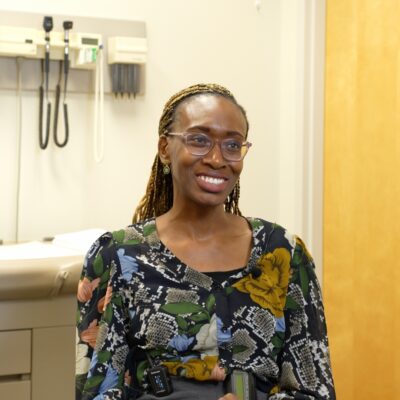Summary of Key Points
- There is a significant knowledge gap regarding non-smoking-related causes of lung cancer.
- The social stigma that is often linked with a lung cancer diagnosis, primarily to smoking tobacco, hinders prevention efforts and support for patients.
- Radon exposure, the second leading cause of lung cancer, remains alarmingly underrecognized.
Radon exposure is the leading cause of lung cancer in people who do not smoke tobacco and poses a serious public health threat across Canada. Radon is a colourless, odourless radioactive gas that naturally occurs in soil and can accumulate to dangerous levels indoors. Long-term radon exposure is linked to over 3,300 lung cancer deaths annually in Canada, making it a significant but often under-acknowledged health risk.
The following perspectives from medical professionals highlight that preventing radon-induced lung cancer requires a proactive approach: empowering Canadians with knowledge, equipping healthcare providers with critical information, and implementing protective measures to mitigate this invisible risk.
The Universal Risk of Lung Cancer and the Importance of Radon Awareness
Dr. Doreen Ezeife is a medical oncologist and professor at the University of Calgary, and she highlights the big problems with the common misconception that only tobacco smokers are at risk of developing lung cancer. “Anyone with lungs can develop lung cancer,” she says, “we are all at risk.” Dr. Eziefe aims to improve awareness of all lung cancer causes, including radon, through her teaching and medical practice. Radon exposure has become a personal concern for Dr. Ezeife, who recently discovered elevated radon levels in her home.
“Our basement tested at 150 Bq/m³, so we must do something about that. We just found that out a few weeks ago, so we haven’t engaged with a radon mitigator yet, but we need to. It’s a priority,” she shares.
Long-term radon exposure above 100 Bq/m³ significantly increases lung cancer risk, with a 16% rise in risk for every additional 100 Bq/m³.
Through her extensive clinical experience with lung cancer, Dr. Ezeife has witnessed firsthand how lung cancer does not discriminate between people. Her experiences in treating patients have shown that environmental factors, such as radon exposure, play a significant role in lung cancer development, making awareness and preventive measures crucial for everyone, regardless of whether they’ve ever used tobacco.
“I just saw a patient who never had a history of tobacco smoking, vaping, or any tobacco exposure, and they have developed lung cancer. The message needs to be that anyone with lungs can develop lung cancer. The stigma that only smoking tobacco causes lung cancer needs to be erased.”

Her encounters with patients who developed lung cancer despite lacking “traditionally” acknowledged risk factors reinforce the need to eliminate the stigma and broaden the public’s understanding of lung cancer causes.
Comprehensive Care and Community Advocacy in Oncology
Dr. Don Morris is the Facility Medical Director of the new Arthur J.E. Child Comprehensive Cancer Center and the Associate Senior Medical Director for Cancer Care Alberta. His experience offers a nuanced view of lung cancer prevention that spans clinical care, education, and public health. He acknowledges that many people understand the link between smoking and lung cancer; however, he notes a gap in awareness around other risks, like radon exposure, that also play a significant role.
“I think people know that if they smoke tobacco, there is a risk of lung cancer,” he explains. “It’s the uncertainty around things like radon… what people need to do is to test their homes.”
Dr. Morris advocates for proactive radon testing. He points out that lung cancer risk isn’t just an individual concern tied to lifestyle choices but can affect entire families through environmental exposure within homes. His focus on environmental factors, especially radon, broadens the conversation about lung cancer, emphasizing that prevention isn’t just about personal habits—it’s about creating safe spaces where families live, work and play. By testing and addressing elevated radon levels, people can significantly lower their long-term risk of developing lung cancer.
A critical aspect of Dr. Morris’s work goes beyond treatment; he’s committed to dismantling the stigma associated with lung cancer. He explains that the disease often carries a negative perception, as the majority of the public still believes lung cancer is solely caused by smoking tobacco. “There are several causes of lung cancer in addition to smoking, and radon is the next most common cause,” he says.
Dr. Morris advocates for a broader understanding of the diverse causes of lung cancer to foster empathy and support for all patients, regardless of their background or habits. By addressing these misconceptions, he aims to improve patients’ quality of life and encourage more people to take preventive measures against radon and other environmental lung cancer risks.
Expertise in Lung Cancer Screening and Prevention
Dr. Alain Tremblay, a researcher, clinician, and medical lead for Alberta’s lung cancer screening programs, observes that while most physicians are aware of radon, many lack in-depth knowledge about its risks. Through his extensive work, Dr. Tremblay emphasizes a critical gap in public and professional understanding of this silent but deadly gas.

“The knowledge rate will drop substantially as soon as you get into detail. It’s important that when we discuss lung cancer, we don’t ignore secondary factors like radon, as they will likely become more prominent over time.”
As a professor at the University of Calgary, Dr. Tremblay believes that the gap in professional understanding of radon starts with medical education. By integrating knowledge about radon and other environmental sources of lung cancer into medical education, he believes future healthcare professionals will be better equipped to recognize and address environmental risks in their patients’ lives.
Dr. Tremblay further stresses that radon awareness must become a part of comprehensive lung cancer prevention strategies. He emphasizes that radon exposure is an environmental issue that demands collective action, requiring the integration of radon testing and mitigation into public health policies. From homes and schools to workplaces, Dr. Tremblay envisions a future where radon testing is routine, ensuring safer environments for all Canadians.
Conclusion
Drs. Ezeife, Morris, and Tremblay’s insights remind us that the fight against lung cancer is complex. Their dedication to research, prevention, and community education highlights the importance of a comprehensive approach to lung cancer awareness. By addressing environmental lung cancer causes like radon exposure and promoting early detection, we can shift the narrative surrounding lung cancer.
